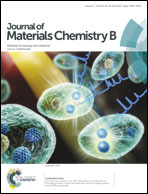Enhanced osteoblast functions and bactericidal effect of Ca and Ag dual-ion implanted surface layers on nanograined titanium alloys†
Abstract
To endow a Ti-based implant with enhanced osteogenic activity and antibacterial property, we herein modified nano-grained (NG) and coarse-grained (CG) Ti surface layers by the implantation of Ca and/or Ag ions, which were derived by surface mechanical attrition treatment (SMAT). The cellular adhesion, proliferation, differentiation (as marked by the osteogenesis-related gene expression, ALP activity and specific protein content) and extracellular matrix mineralization of hFOB1.19 osteoblasts, as well as the bacterial adhesion of Staphylococcus aureus and Escherichia coli on as-SMATed and different ion-implanted surfaces, were also investigated. The obtained results show that Ca and/or Ag ion implantation almost does not significantly alter the surface roughness and topography of the SMATed layers; moreover, it has little influence on the microstructure of the SMAT-achieved Ti nanograins. Furthermore, the implanted Ca and Ag are in the form of CaTiO3 and metallic Ag nanoparticles (NPs), respectively, and are embedded tightly in the Ti matrix. Significant enhancements of osteoblast functions are exhibited on the NG and ion-implanted NG surfaces compared to the CG and ion-implanted CG surfaces, which is related to the grain size and hydrophilicity of the surfaces. Although the Ca and Ag dual-ion implanted CG surface can simultaneously enhance the osteogenic activity and antibacterial properties compared to the CG surface, the enhancement of dual functions is more pronounced on the dual-ion implanted NG surface because the NG surface is more beneficial to the implantation of Ag and Ca ions compared to the CG surface. Although surface chemistry and hydrophilicity are responsible for the various antibacterial properties of the surfaces, the Ag NPs in the ion-implanted surfaces play a dominant role in the bactericidal ability compared to the hydrophilicity. Our study provides a promising means for designing biomaterial surfaces such that their osteoblast functions and antibacterial activity are perfectly balanced.


 Please wait while we load your content...
Please wait while we load your content...